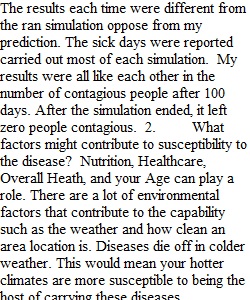


Q Getting Started In this course you have read and discussed the impact that the human population has on the global environment. Likewise it is important that we consider the effect that the environment can have on the human population. Infectious diseases are the second leading cause of death worldwide (Essential Environment, 2015). In this lab you will have the opportunity to observe scenarios that simulate the spread of infectious diseases. By changing parameters in the lab simulations you will observe how factors such as population size, population mixing and vaccinations influence the spread of infectious diseases. Upon successful completion of this assignment, you will be able to: • Make scientific predictions, analyze scientific data and theorize how the information can be applied. ________________________________________ Resources • Textbook: Essential Environment: The Science Behind the Stories • Website: The Habitable Planet: A Systems Approach to Environmental Science, Interactive Labs • File: WS4 Lab Disease • Video: WS4 Lab Tutorial. ________________________________________ Instructions 1. Review the rubric to make sure you understand the criteria for earning your grade. 2. Read Chapter 10 in Essential Environment: The Science Behind the Stories 3. Watch WS4 Lab Tutorial. 4. Download the WS4 Lab_Disease file. 5. Navigate to The Habitable Planet, Disease Lab a. Read and complete the lab lessons The Virgin Field, Step 1 and 2; Vaccination, Step 2; and Pandemic, Step 1. b. Record data and answer questions in the WS4 Lab_Disease document (do not download the data table from the interactive lab) 6. The writing must follow APA requirements. 7. When you have completed your assignment, save a copy of your completed lab document for yourself and submit a copy to your instructor using the Assignment submission page by the end of the workshop ________________________________________ Access the associated rubric Access the Assignment submission page Navigate to the websitehttps://www.learner.org/courses/envsci/interactives/disease/. Complete the lab lessons entitled “The Virgin Field” and “Vaccination” and “Pandemic”. Record your data in the tables below and answer the analysis questions that follow each step. Courtney Murray 9/22/2022 Lesson 1: The Virgin Field Read the lab Overview and The Virgin Field: Step 1. Click on Open Simulator. Set the simulator to “Virgin Field” in the upper drop-down menu. In the Simulation Parameters box set Disease to “Kold”, Population Density” to “Medium” and Population Mixing to “None.” Fill out the prediction row below. For the number of sick days, enter a number that you think will be reported in 100 days. You will use the formulas below the table to calculate the Number of Infections in the Population and the Infection Rate (%). Run the simulator to 100 days, record data in the table. To determine the number of contagious people at 100 days, hold your cursor arrow over the graph lines at the 100 day time to display the values (or count the red dots). Repeat this simulation two additional times and enter the data in the chart below Lesson 1: The Virgin Field Step 1 Population Number Starting Number of Contagious People Sick Days Reported Number of Contagious People after 100 days Number of infections in the population Infection Rate (%) Prediction 600 20 800 480 200 80 Simulation Run 1 600 4 1537 0 307.4 51.23 Simulation Run 2 600 3 57 0 11.4 1.9 Simulation Run 3 600 3 957 0 191.4 31.9 Using the formulas below, calculate a) the # of infections that occurred in the population and b) the % Infection Rate for each simulation. Record the values in the data table # sick days reported a) 5 days(duration of Kold) = # of infections in the population b) (# of infections / population number) x 100 = % infection rate Step 1 Analysis Questions: answer the following using complete sentences. 1. Do you get the exact same results each time you run the simulation? How do the results compare to each other and to your prediction?
View Related Questions